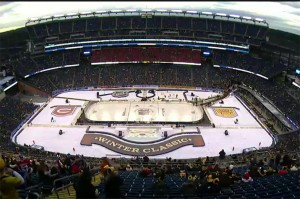NBC Sports Adds Skycam Wildcat to NHL Winter Classic
New system helps create ‘spectacle feel’ to coverage
Story Highlights
NBC Sports’ eighth NHL Winter Classic is in the books, and, although the telecast may not have featured the falling snow or bitter-cold temperatures that have marked some previous installments, the 2016 Classic at Gillette Stadium featured plenty of NBC’s trademark “spectacle” production elements that have made the outdoor game a unique New Year’s Day tradition.
“The weather and being in a much larger venue than a typical NHL arena always pose challenges. … We’ve done Winter Classics in football stadiums before, [but] no two are the same,” said Ken Goss, SVP, remote operations and production planning, NBC Sports/NBCSN/Golf Channel, prior to the game in Foxboro, MA. “The Winter Classic is technically more demanding than a Stanley Cup Final. We’ve added Skycam and RF handhelds over the years to give the game more of a spectacle feel.”

NBC Sports drew on experience with other NHL games to produce Winter Classic.
In producing its most technically demanding NHL production of the year, NBC has learned much from previous installments and has also gained a leg up, thanks to its increased number of NHL productions prior to the Winter Classic as a result of Comcast’s acquisition of NBCU.
“Before the [Comcast-NBC] merger, the Winter Classic was the first game of the season produced by NBC. Envision having to produce the Super Bowl as the first game of the year,” explained James Stuart, director, NHL and college hockey remote operations, NBC Sports Group. “Now, with all the regular-season games NBC and NBCSN produce prior to the Winter Classic, it gives us the opportunity to have our crew break in any new equipment and work out the kinks before the game.’
Skycam Wildcat Creates Classic Perspectives
The Peacock’s 34-camera complement (including the feeds NBC took from other rightsholders) was headlined by the Skycam Wildcat four-axis stabilized aerial camera system. Used extensively throughout the telecast, the new system (which debuted at the MLS All-Star Game last July and has been used on NBC Sunday Night Football all season) is capable of moving at speeds in excess of 25 miles per hour, creating shots rarely seen in hockey coverage.
Besides the Skycam WildCcat, NBC Sports deployed a Grass Valley LDX 86 Universe 6X slo-mo, a Sony 3300 3X slo-mo, two RF handhelds, two robos (speed and left rocker), and an airplane aerial shot provided by WingedVision. In addition, NBC was supplied with a right-rocker robo from Sportsnet and netcams from TVA, one of many instances in which the three networks pooled their resources.
“Cooperation between NBC, Rogers, and TVA has also helped streamline production,” said Stuart. “There is a lot more sharing of facilities and resources, which has led to better production planning: for example, coordinating who covers the teams walking out and coaches’ pregame speeches. This enables us to be more efficient for television, as we all share the one camera in the locker room. This also makes television less intrusive on the teams.”
On the audio side, NHL on NBC lead A1 Tim Dunn and his team produced the Winter Classic in 5.1 surround sound for the first time.
Inside the Foxboro Compound
NBC, which once again worked onsite in tandem with Canadian-rights holder Rogers Sportsnet and Canadian-French-language–rights holder TVA, used NEP’s ND6 and Super Bee as its A and B units, respectively. As has been the case in recent years, NBC worked closely with the NHL and its fellow rightsholders to create efficiencies in the compound and cut down on costs and labor.
The Winter Classic has also become more operationally efficient with the help of the NHL,” said Stuart. “For example, the NHL now coordinates the generators for all the rightsholders and parses out as needed: one vendor onsite for all, instead of each rightsholder bringing in their preferred vendor. This has helped with laying out the compound space and reduced costs for all involved.
“Another major area of efficiency,” he continued, “is the NHL coordinating cable assignments with Bexel. The Winter Classic normally has three or four shows. With Bexel coordinating the cable assignments, all the rightsholders show up, and there is no confusion as to which cables are to be used by each rightsholder.”
In addition to creating efficiencies onsite, NBC used a 300-Mbps fiber pipe between Gillette Stadium and its broadcast center in Stamford, CT, for exchanging content. This allowed NBC to base all editing operations for teases, promos, and features in Stamford. Although this workflow is new to NBC’s NHL coverage this season, it has been in place whenever ND-5 or ND-6 has been used for regular-season games.
Embracing Their Surroundings
The NHL provided onsite studio sets for all rightsholders on the bridge by the lighthouse in the stadium. NBC used the same desk it used for last year’s Winter Classic in Washington, DC, as well as for Stanley Cup Final and NHL Stadium Series games.
Working at an NFL stadium for the first time since 2011 (Heinz Field in Pittsburgh) meant that NBC and the Patriots would be sharing space.
“It has not affected setup, but it does pose a challenge in regards to the amount of office/meeting space available,” said Goss. “The stadium itself has not presented any major challenges. The support from the stadium and Patriots in seeing the Winter Classic become a success has been clearly evident. Another plus is that a majority of our crew has worked here numerous times for football and know their way around. Having done other Winter Classics in NFL stadiums has also prepped us for what to expect and how to navigate obstacles.”
